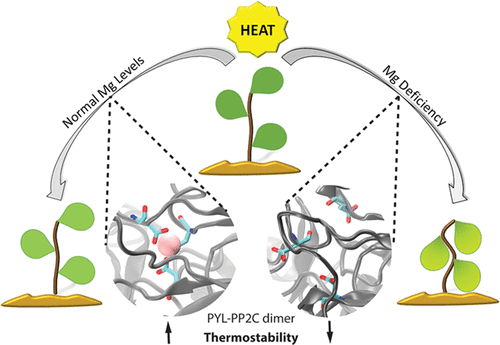当前位置:
X-MOL 学术
›
J. Chem. Inf. Model.
›
论文详情
Our official English website, www.x-mol.net, welcomes your
feedback! (Note: you will need to create a separate account there.)
Thermostability of the PYL–PP2C Heterodimer Is Dependent on Magnesium: In Silico Insights into the Link between Heat Stress Response and Magnesium Deficiency in Plants
Journal of Chemical Information and Modeling ( IF 5.6 ) Pub Date : 2018-02-13 00:00:00 , DOI: 10.1021/acs.jcim.7b00655 Emel Timucin 1 , Osman Ugur Sezerman 1
Journal of Chemical Information and Modeling ( IF 5.6 ) Pub Date : 2018-02-13 00:00:00 , DOI: 10.1021/acs.jcim.7b00655 Emel Timucin 1 , Osman Ugur Sezerman 1
Affiliation

|
Magnesium deficiency increases the susceptibility of plants toward heat stress. The correlation between magnesium levels and stress response has been studied at the physiological level; albeit, the molecular explanation to this relationship remains elusive. Among diverse pathways implicated in the heat stress, the abscisic acid (ABA) signal modulates the heat stress response by magnesium dependent phosphatases (PP2Cs). Exclusively, sequestration of PP2Cs by ABA receptors (PYLs) in the heterodimer form activates the stress response through ABA responsive transcription factors. In this study, the molecular interplay between magnesium levels and ABA related heat stress response was investigated. Molecular dynamics simulations have been applied to two different PYL–PP2C heterodimer systems representing normal and magnesium deficient conditions. The heterodimer conformation and stability were delineated at high temperatures mimicking heat stress. Results showed that the thermostability of the heat stress response heterodimer was significantly dependent on the magnesium. Furthermore, a conserved aromatic cluster at the dimer interface acted synergistically with the metal to confer thermostability to the heterodimer structure. These structural insights into one of the possible links between magnesium levels and stress highlight the importance of metal micronutrients for tuning the stability of the stress-related proteins and optimizing tolerance.
中文翻译:

PYL–PP2C异二聚体的热稳定性取决于镁:在计算机上对植物热应激反应和镁缺乏之间联系的见解
镁缺乏会增加植物对热胁迫的敏感性。已经在生理学水平上研究了镁水平与应激反应之间的相关性。虽然,对此关系的分子解释仍然难以捉摸。在涉及热应激的各种途径中,脱落酸(ABA)信号通过镁依赖性磷酸酶(PP2C)调节热应激反应。排他性地,异源二聚体形式的ABA受体(PYL)隔离PP2Cs通过ABA响应转录因子激活应激反应。在这项研究中,研究了镁水平与ABA相关的热应激反应之间的分子相互作用。分子动力学模拟已应用于代表正常和镁缺乏条件的两种不同的PYL–PP2C异二聚体系统。在模拟热应力的高温下描绘了异二聚体的构象和稳定性。结果表明,热应激反应异二聚体的热稳定性显着依赖于镁。此外,在二聚体界面处的保守的芳族簇与金属协同作用以赋予异二聚体结构热稳定性。这些对镁含量和压力之间可能存在的联系之一的结构洞察力凸显了金属微量营养素对于调节压力相关蛋白的稳定性和优化耐受性的重要性。二聚体界面处的保守芳族簇与金属协同作用,赋予异二聚体结构热稳定性。这些对镁含量和压力之间可能存在的联系之一的结构洞察力凸显了金属微量营养素对于调节压力相关蛋白的稳定性和优化耐受性的重要性。二聚体界面处的保守芳族簇与金属协同作用,赋予异二聚体结构热稳定性。这些对镁含量和压力之间可能存在的联系之一的结构洞察力凸显了金属微量营养素对于调节压力相关蛋白的稳定性和优化耐受性的重要性。
更新日期:2018-02-13
中文翻译:

PYL–PP2C异二聚体的热稳定性取决于镁:在计算机上对植物热应激反应和镁缺乏之间联系的见解
镁缺乏会增加植物对热胁迫的敏感性。已经在生理学水平上研究了镁水平与应激反应之间的相关性。虽然,对此关系的分子解释仍然难以捉摸。在涉及热应激的各种途径中,脱落酸(ABA)信号通过镁依赖性磷酸酶(PP2C)调节热应激反应。排他性地,异源二聚体形式的ABA受体(PYL)隔离PP2Cs通过ABA响应转录因子激活应激反应。在这项研究中,研究了镁水平与ABA相关的热应激反应之间的分子相互作用。分子动力学模拟已应用于代表正常和镁缺乏条件的两种不同的PYL–PP2C异二聚体系统。在模拟热应力的高温下描绘了异二聚体的构象和稳定性。结果表明,热应激反应异二聚体的热稳定性显着依赖于镁。此外,在二聚体界面处的保守的芳族簇与金属协同作用以赋予异二聚体结构热稳定性。这些对镁含量和压力之间可能存在的联系之一的结构洞察力凸显了金属微量营养素对于调节压力相关蛋白的稳定性和优化耐受性的重要性。二聚体界面处的保守芳族簇与金属协同作用,赋予异二聚体结构热稳定性。这些对镁含量和压力之间可能存在的联系之一的结构洞察力凸显了金属微量营养素对于调节压力相关蛋白的稳定性和优化耐受性的重要性。二聚体界面处的保守芳族簇与金属协同作用,赋予异二聚体结构热稳定性。这些对镁含量和压力之间可能存在的联系之一的结构洞察力凸显了金属微量营养素对于调节压力相关蛋白的稳定性和优化耐受性的重要性。











































 京公网安备 11010802027423号
京公网安备 11010802027423号